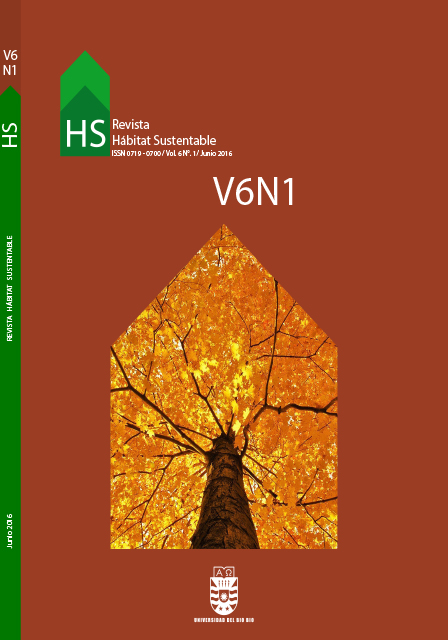Estratégia para a incorporação de impactes ambientais, sociais e económicos específicos num método de Avaliação da Sustentabilidade de Edifícios de Saúde (HBSA method)
DOI:
https://doi.org/10.22320/07190700.2016.06.01.04Palavras-chave:
métodos de avaliação, métodos de avaliação, método HBSA, método HBSA, edifícios de saúde, edifícios de saúde, hospitais, sustentabilidade, hospitais, sustentabilidadeResumo
O projeto de um ambiente hospitalar requer uma série de preocupações com a satisfação e bem- estar da equipa de trabalho, pacientes e administradores, ao mesmo tempo que possui uma forte responsabilidade social e impacte na cidade. Atualmente, veri ca-se que a maioria deste tipo de edifícios não é concebida ou utilizada de forma sustentável, apesar de já existirem algumas ferramentas que têm vindo a ser desenvolvidas com o objetivo de serem utilizadas no suporte de decisões que permitam otimizar a sustentabilidade dos mesmos. Tendo por base este contexto, o presente artigo tem como objetivos discutir as barreiras existentes na disseminação de práticas sustentáveis nos edifícios de saúde e apresentar uma proposta de estrutura para uma metodologia que, dando resposta a algumas das barreiras identi cadas, facilite a incorporação de princípios de sustentabilidade durante as diferentes fases do ciclo de vida de um edifício hospitalar. A estrutura apresentada é orientada para o contexto português e encontra-se baseada no trabalho desenvolvido até então pelas organizações ISO e CEN e noutras metodologias internacionais de avaliação da sustentabilidade já disponíveis no mercado.
Downloads
Referências
ACSS. Recomendações e especi cações técnicas do Edifício Hospitalar. 2011. Lisboa: ACSS - Administração Central do Sistema de Saúde, 2012.
ACSS. Guia de boas práticas para o sector da saúde. 1.3 (2013). Lisbon: ACSS, 2013.
ACSS. Portal da Saúde [online], 2016. [Dta de consulta: 14 de maio 2016]. Disponível em: http://www.portaldasaude.pt/portal.
ASHE. Green healthcare construction guidance statement. Chicago: ASHE, 2002.
BAUM, Mara e SHEPLEY, Mardelle. Eco-Effective Design & Evidence- Based Design. Documento apresentado em: Cleanmed. Chicago, 2009, pp. 1–63.
BAUM, Mara; SHEPLEY, Mardelle; GINSBERG, Rachel e ROSTENBERG, Bill. Eco-Effective Design and Evidence-Based Design: Perceived Synergy and Con ic. HERD, 2009a, vol. 2, no. 3, pp. 56–70.
BAUM, Mara; SHEPLEY, Mardelle; ROSTENBERG, Bill e GINSBERG, Rachel. Eco-Effective Design and Evidence-Based Design: Removing Barriers to Integration. 1. San Francisco: AIA Board Knowledge Committee, 2009b.
CASTRO, Maria de Fátima; MATEUS, Ricardo e BRAGANÇA, Luís. Proposal for a Healthcare Building Sustainability Assessment (HBSA) Method. Em: World SB14 Barcelona. vol. 5. Barcelona: GBCe, 2014, pp. 607–613.
CASTRO, Maria de Fátima; MATEUS, Ricardo e BRAGANÇA, Luís. A critical analysis of building sustainability assessment methods for healthcare buildings. Environment, Development and Sustainability, 2015a, vol. 17, no. 6, pp. 1381–1412.
CASTRO, Maria de Fátima; MATEUS, Ricardo e BRAGANÇA, Luís. Estratégia para a incorporação de impactes ambientais, sociais e económicos especí cos num método de Avaliação da Sustentabilidade de Edifícios de Saúde (HBSA). Em: Latin American European Conference on Sustainable Buildings and Communities. EURO ELECS 2015, Guimarães, 2015b.
CASTRO, Maria de Fátima; MATEUS, Ricardo; BRAGANÇA, Luís e SERÔDIO, Francisco. Development of Benchmarks for Operating Costs and Resources Consumption to be Used in Healthcare Building Sustainability Assessment Methods. Sustainability, 2015, vol. 7, no. 10, pp. 13222–13248.
GUENTHER, Robin e VITTORI, Gail. Sustainable healthcare architecture. 1. Nova Jérsia: John Wiley & Sons, Inc., 2008.
GUENTHER, Robin e VITTORI, Gail. Sustainable healthcare architecture. 2. Nova Jérsia: John Wiley & Sons, Inc., 2013
HAMILTON, Kirk. Four Levels of Evidence-Based Practice. AIA Journal of Architecture. Nova Iorque: AIA, 2006, pp. 1–2.
ISO TS. ISO/AWI 21929, Building Construction – Sustainability in Building Construction – Sustainability Indicators - Part 1 - Framework for the development of indicators for buildings and core indicators. 2010. Geneva: ISO, 2010.
LEE, Wai-ling; CHAU, Chi-kwan; YIK, Francis; BURNETT, John e TSE, Man Sze. On the study of the credit-weighting scale in a building environmental assessment scheme. Building and Environment, 2002, vol. 37, no. 12, pp. 1385–1396.
MATEUS, Ricardo. Avaliação da Sustentabilidade da Construção. Guimarães: Escola de Engenharia da Universidade do Minho, 2009.
PENTLAND, William. Heal Thy Self: U.S. Hospitals Are Huge Energy Hogs. Forbes [online] [Data de consulta: 17 de outubro de 2013]. Disponível em: http://www.forbes.com/sites/ williampentland/2012/08/20/u-s-hospitals-are-huge-energy-hogs- better-light-bulbs-are-not-the-solution/.
ROBERTS, Greg e GUENTHER, Robin. Environmentally Responsible hospitals. Em: S. MARBERRY (ed.), Improving healthcare with better building design. 1. Chicago: Health Administration Press, 2006, pp. 81–107.
VAQUERO, Petra. Edifícios de saúde: Qual o caminho para a e ciência energética? Em: A. MALHEIRO (ed.), Tecno Hospital – revista de engenharia e gestão da saúde. vol. 58. Lisboa: EH ATEHP, 2013, pp. 18–20.
Downloads
Publicado
Como Citar
Edição
Secção
Licença
Direitos de Autor (c) 2016 Hábitat Sustentable

Este trabalho encontra-se publicado com a Licença Internacional Creative Commons Atribuição-CompartilhaIgual 4.0.
O conteúdo dos artigos publicados em cada número do Habitat Sustentável é da exclusiva responsabilidade dos autores e não representa necessariamente o pensamento ou compromete a opinião da Universidad del Bío-Bío.
Os autores mantêm os seus direitos de autor e concedem à revista o direito de primeira publicação da sua obra, que está simultaneamente sujeita à Licença de Atribuição Creative Commons CC BY-SA que permite a outros partilhar, transformar ou criar novo material a partir desta obra para fins não comerciais, desde que a autoria e a primeira publicação nesta revista sejam reconhecidas, e as suas novas criações sejam licenciadas sob os mesmos termos.











 Programa de Informação Científica/Concurso Fondos de Publicación de Revistas Científicas 2018/ Proyecto Mejoramiento de Visibilidad de Revistas UBB (Código:FP180007)
Programa de Informação Científica/Concurso Fondos de Publicación de Revistas Científicas 2018/ Proyecto Mejoramiento de Visibilidad de Revistas UBB (Código:FP180007)





